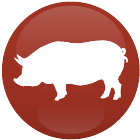|
Ventilation systems in swine production have come a
long way from basic airflow management to sophisticated technologies
that play a crucial role in optimizing swine health, productivity, and
overall barn efficiency. As demands on producers increase due to
environmental regulations, animal welfare expectations, and economic
pressures, advancements in ventilation technology have become
indispensable for modern operations.
A Historical Perspective
Traditionally, swine barns relied on natural
ventilation or simple mechanical systems to regulate airflow. These
methods were often inconsistent, leaving producers to battle seasonal
challenges such as extreme heat, cold, or humidity. While functional,
these systems lacked the precision required to maintain the optimal
environment pigs need for growth and health.
Over time, the industry recognized the need for
more efficient solutions, sparking innovation in automated systems and
intelligent controls. Early systems addressed temperature regulation,
but today’s technology goes far beyond mere climate control.
Modern Ventilation: A Game-Changer
Modern swine ventilation systems integrate
sensors, automation, and data analytics to create a dynamic environment
tailored to the needs of the animals. These systems adjust temperature,
humidity, and air quality in real time, ensuring a consistent and
comfortable environment regardless of external conditions.
Key features of today’s ventilation systems include:
• Automated Controls: Systems that automatically adjust based on barn conditions, reducing the need for manual intervention.
• Air Quality Monitoring: Sensors that track
ammonia, CO2, and other harmful gases, triggering adjustments to improve
air quality.
• Zoned Ventilation: The ability to customize
airflow for different areas of the barn, accommodating the needs of pigs
at various stages of growth.
• Energy Efficiency: Advances in fan design and heat recovery systems that minimize energy use while maximizing performance.
Impact on Swine Health and Productivity
The direct benefits of modern ventilation systems
are evident in the health and productivity of pigs. Proper ventilation
reduces the risks of respiratory diseases caused by poor air quality,
such as ammonia buildup. It also minimizes heat stress, which can
significantly impact feed conversion and growth rates.
Moreover, a well-ventilated barn enhances worker
conditions, reducing fatigue and promoting better management practices.
Producers often see improved efficiency and lower operational costs,
making advanced ventilation systems a sound investment.
Looking Ahead: What’s Next?
As we look to the future, the integration of smart
technology and precision farming tools will continue to revolutionize
swine ventilation. Predictive analytics, powered by AI, will allow
systems to anticipate environmental changes and adapt proactively.
Remote monitoring and control will become standard, giving producers
greater flexibility and control over their operations.
At PigTek, we are committed to staying at the
forefront of these advancements. By leveraging cutting-edge technology,
we help producers create environments where pigs can thrive,
productivity can increase, and operations can become more sustainable.
Conclusion
The evolution of swine ventilation technology
highlights the industry’s dedication to improving animal welfare,
producer profitability, and environmental sustainability. With
continuous advancements, producers have access to tools that not only
meet today’s challenges but also prepare them for the demands of the
future.
For more information on PigTek’s ventilation solutions, visit www.pigtek.net.
________________________________________
Chris Elvidge
is a swine industry expert with PigTek, specializing in advanced
agricultural solutions that enhance animal welfare and operational
efficiency.
| 












